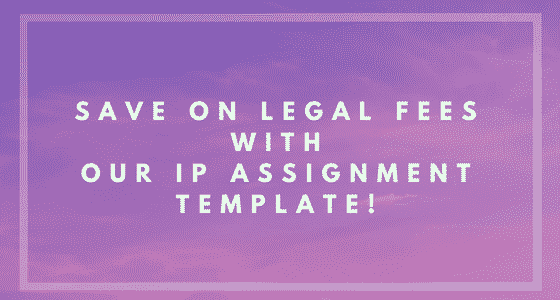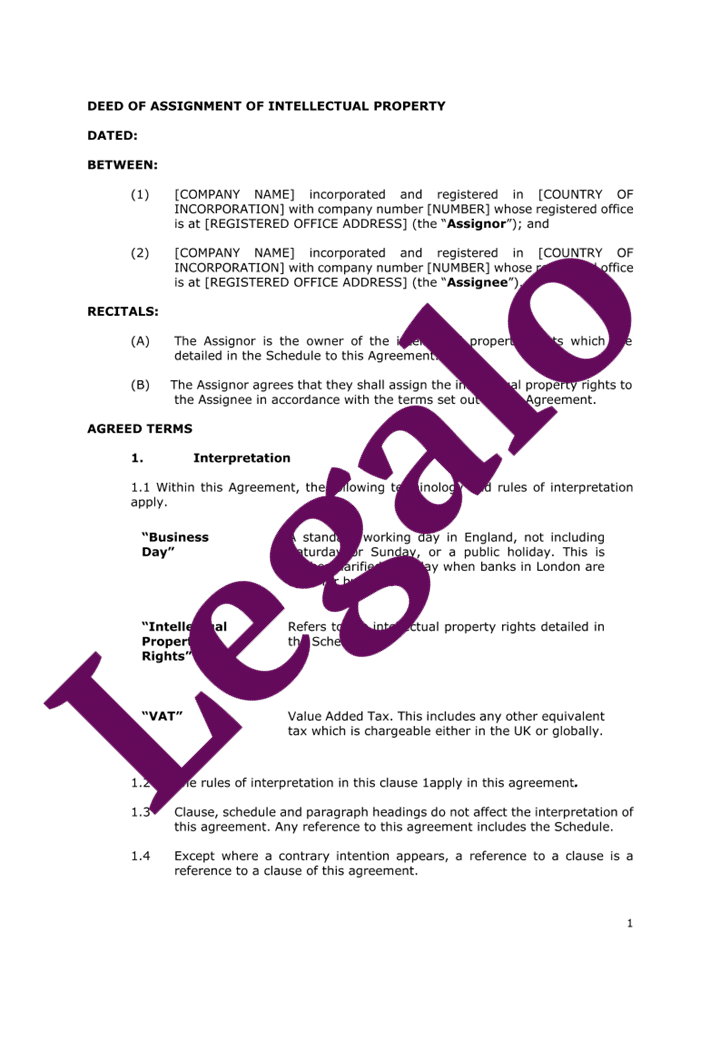Intellectual Property Assignment Agreement
Our Intellectual Property Assignment template:
- Easily create an Intellectual Property Assignment
- Specialist Solicitor-drafted assignment template for reliability
- Customise to your requirements
- Full guidance notes included for easy drafting
- Our money-back satisfaction guarantee

How Does It Work?
-
1. Download
-
2. Edit
-
3. Print
-
4. Sign
Our Intellectual Property Assignment has been drafted so that it covers all types of Intellectual Property (IP). The Intellectual Property Assignment (often called an IP Assignment) agreement enables you to transfer intellectual property easily from one party to another.
You can use this agreement template to transfer the following types of intellectual property rights:
- Trademarks;
- Copyright;
- Design Rights; and / or
- Patents.
If you want to transfer know-how or confidential information along with the IP rights, then we recommend that you use our Technology Transfer Agreement, instead of this IP Assignment. When you only need to cover trademarks, then you may prefer our Trademark Assignment, as it is:
- more to the point and
- covers in more detail what you need to do to register the assignment of a registered trademark with the IPO.
If you only want to sell or transfer copyright material, then use our Copyright Assignment.
For patents only, use our Patent Assignment. Similarly just for design rights try our template Design Right Assignment.
When to Use an Intellectual Property Assignment Agreement
The intellectual property laws existing here in the UK state that if you have created artwork, music, written works, discoveries, inventions, symbols, etc, you have exclusive rights to them. This is the case unless you create the IP in question in your capacity as an employee of a company. In that case, the employer owns the intellectual property.
As the owner of intellectual property rights, you may want to transfer those rights to another party. If you are transferring IP rights in return for a monetary payment, then you are deemed to be assigning those rights. If, however, you are transferring the IP for no monetary payment, then you are deemed to be transferring the rights.
In both cases it is necessary to document the transfer in writing. Use our IP Assignment template to do this.
Using our IP Assignment Template
An IP specialist UK solicitor has drafted our template, so that it is legally binding in England, Scotland and Wales. You can purchase our documents knowing that they are easy to use and great value for money.
You may hire a consultant or freelancer to create new ideas or products. When you have them sign an Assignment of Intellectual Property, then you are transferring the IP from them to you.
It will state that any ideas or products from them will become the intellectual property of your business, instead of the consultant. It eliminates the possibility that the consultant could use the idea or product to reproduce it or sell it to another company.
Although you will find the document includes some legal terminology, it will be easy for you and the other party to understand. The guide that comes with the template explains each clause and terminology as you go along, so it is very easy to use. Download the template to your computer, and you can begin filling it out right away.
Need Help With This IP Assignment Template?
Whatever questions you have regarding this intellectual property assignment template, we are here to help you. Our team of customer support advisers cannot provide legal advice, but they can advise you on using this agreement. For example, whether this or another agreement template is right for you. We can also answer any questions that you have when you get to completing the IP assignment agreement.
FAQs on Intellectual Property Assignments
Below, we answer many of the top questions about IP assignments from the Internet.
How do you transfer intellectual property?
If you wish to transfer Intellectual Property or “IP” to another party, you will need a legal agreement known as an assignment. An assignment of intellectual property gives the party to whom the rights are being transferred full rights of ownership over the intellectual property. The agreement should include all the relevant details about the transfer itself, and list all the IP that the owner is selling. At Legalo, we have such an assignment, which you can use, safe in the knowledge that we have covered all legal eventualities.
Once you have the agreement in place, any IP that is registered needs 1 more step. You need to notify the registry that the ownership has changed. In the UK, this means the Intellectual Property Office. This step applies in particular to:
- patents (they are always registered)
- registered trademarks (only some trademarks are registered); and
- registered design rights (only some design rights are registered).
What is an assignment of IP rights UK?
An assignment of IP rights is a legal transfer of ownership of intellectual property from one party (the assignor) to another party (the assignee). You do this through a written agreement outlining the terms of the transfer, along with any price or royalties involved. It results in the complete transfer of all rights, title, and interest in the IP, allowing the assignee to become the new owner. The assignment is typically covered in a written agreement that specifies the details of the transfer, including:
- the IP involved, and
- any price for the IP.
For any registered IP, such as a registered trade mark or patent, following the assignment, the owner would apply to the registry to have the assignment of the trade mark or patent noted, so it is clear who the new owner is.
Is an assignment a transfer of ownership?
Yes, an assignment is a legal mechanism for the transfer of ownership, so it means the sale of the IP in this context. An assignment of IP involves the transfer of all rights, title, and interest in the IP from one party to another. You use the assignment agreement to set out the terms of the transaction and provide evidence of the sale of the IP.
Does an assignment of IP need to be in writing?
Yes, an assignment of intellectual property generally needs to be in writing to be legally enforceable. In many jurisdictions, including the UK, a written agreement is necessary to transfer ownership rights. A written assignment agreement provides clarity on the details of the transfer, such as the type of IP, the rights being transferred, and any price or other conditions. For any IP that is registered, the written agreement is a precursor to advising the registry that the ownership has changed. If the IP is not registered, the written agreement would serve as the only proof of the new ownership, so is very important.
What are the key components of an IP assignment? What is an example of an intellectual property assignment agreement?
An example of an intellectual property assignment agreement is a legal document that facilitates the transfer of intellectual property rights from one party to another. It includes details such as:
- the identification of the intellectual property that the owner is assigning,
- the parties involved,
- the scope of rights being transferred,
- the consideration or payment terms (for example, royalties),
- the date on which the agreement comes into effect, and
- any warranties or representations.
The agreement may also address confidentiality, dispute resolution, and governing law provisions.
What is an IP transfer agreement?
An IP transfer agreement, also known as an intellectual property assignment, is a legal document that transfers ownership of intellectual property rights from one party to another. It sets out the terms of the transfer. Having a written agreement:
- ensures that the parties properly transfer the ownership and rights to the intellectual property to the recipient,
- protecting the parties’ interests,
- allowing the new owner to be registered as the owner of the IP, if it is registered IP, and
- enabling them to exploit or use the IP as agreed upon.
What is an example of intellectual property? What is intellectual property and list 4 examples? What are 3 different examples of intellectual property?
Intellectual property is an asset or right created by the law and often it is not a physical asset, but it might have an associated, physical form in some cases. For example, copyright is the intellectual property in a book, but it is not the book itself. It is the legal protection that the law gives to the author’s rights in the book. Examples of different types of intellectual property are:
- copyright,
- design rights,
- patents,
- trademarks.
Owners can use these rights to protect all sorts of property, such as logos, software, plant varieties, chemical formulae, inventions, books, music and lyrics.
What is the difference between a patent, a copyright, and a trademark?
While patents, copyrights, and trademarks all fall under the umbrella of intellectual property protection, they each correspond to different types of creations and create distinct legal rights. Here is a basic description of the three most common types of IP protection:
Patent
- A patent protects new inventions or processes and grants the inventor exclusive rights to make, use, and sell the invention for a limited time. You must register a patent in order to gain the legal protection.
Copyright
- Copyright protects original artistic and literary works, and the creative industries naturally use it the most. It gives the creator exclusive rights to reproduce, distribute, perform, or display works based on the original creation and typically lasts for the creator’s lifetime plus a certain number of years (70 in the UK, but it varies in other countries). You cannot register copyright in the UK, but in some other countries you can register copyright.
Trademark
- A trademark protects unique brand or product names, logos, strap-lines, symbols, and other clear indicators of a company, service or product. It allows the owner of the brand to prevent others from using it themselves, avoiding misunderstandings and smeared reputations in the eyes of the consumer. It avoids competitors trading off your good reputation by pretending to be your brand. In the UK, there are both registered and unregistered trademarks, so registration is possible but optional.
Is an assignment of intellectual property a licence?
An assignment is not the same as a licence. An assignment of intellectual property transfers the ownership of the IP from one owner (maybe the inventor or author) to someone else. Often the buyer pays a one-off price for this purchase of the IP rights.
A licence is:
- merely permission from the owner for someone to use the rights in some way (dependant on what the owner permits),
- often on a short-term basis,
- usually in return for the payment of an on-going royalty,
- but the rights remain owned by the owner.
What is the difference between IP ownership and assignment?
IP ownership refers to the legal status of being the rightful owner of intellectual property. This means having exclusive rights and control over its use. On the other hand, IP assignment is the act of transferring (i.e. selling) ownership rights from one party to another. So ownership refers to the current status of owning IP rights, while assignment is the process of transferring those rights to another party.
What is the difference between transfer and assignment of intellectual property rights?
You can use the terms “transfer” and “assignment” interchangeably. They both mean the transfer or sale of rights from one party to another.
Do you need consideration for assignment of IP?
In the UK, the law requires consideration (i.e. something of value that the parties exchange – the price) to make an intellectual property assignment legally valid, unless the parties sign the contract as a “deed”. Consideration can take the form of monetary payment, royalties or licensing fees, exchange of services or assets, or equity or shares in a company. If you sign the contract as a deed, then there is no need to prove there was any consideration for the transfer of the IP.
Can you use someone else’s intellectual property?
Using someone’s intellectual property without the proper permission can lead to legal liability, such as claims of copyright infringement or trademark violations. So it is important to make sure you have authorisation before doing so. However, there are some situations where the law protects you from legal action when using someone’s intellectual property in a minor way, such as:
- Fair Use. This allows use of IP for the purposes of commentary, criticism, education, or research. This is provided that your creation derived from the IP is deemed to be substantively different. So, for example, you can write a review of a book and include short quotes from it. But you cannot copy large passages of it.
- Parody and Satire. Satirising IP can fall under the umbrella of ‘fair use’, so long as it meets the same set of criteria.
- Public Domain. Once the limited time for which the law protected an item of IP has expired, the IP falls into the public domain. Then anyone can freely use it. A creator can also place their own IP into the public domain before its copyright expires. So for example, Charles Dickens wrote his novels and then died a long time ago. The copyright in them has long since expired. So anyone can copy and republish his books now.
- Creative Common Licences. Some creators license their work to allow others to use it free of charge for, or in, their own creations. Sometimes this permission is subject to certain limitations.





